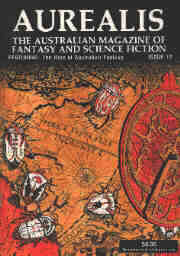Aurealis #131
$3.99
Don’t miss the Aurealis #131 experience! Start with Joshua J Newnes’ fable-like ‘Secondhand Hearts’; move to J Ashley-Smith’s immersive ‘In Memoriam’; take in the time-travel of Davide Mana’s ‘A Piece of the Action’; pass through the portal with the conquistadors of Dirk Strasser’s Conquist Part 5: ‘The Curse of Honour’; and then take the time to enjoy our smorgasbord of articles and reviews.
All Aurealis store prices are in USD
- From the Cloud — Dirk Strasser
- Secondhand Hearts — Joshua J Newnes
- In Memoriam — J Ashley-Smith
- A Piece of the Action — Davide Mana
- CONQUIST Part 5: The Curse of Honour — Dirk Strasser
- The Life and Times of a Steampunk Enthusiast — Lynne Lumsden Green
- What We Can Learn from Neil Gaiman and Terry Pratchett’s Good Omens — Claire Fitzpatrick
- The Trouble with Terminators — Daniel Thompson
Do you remember when ‘going viral’ was likely to be a cause for celebration? Only a few short months ago it was the ultimate measure of success in the world. It was the exponential shortcut to fame, fortune and influence. Now it feels like another world.
The recent publication of Adam Kucharski’s book The Rules of Contagion: Why Things Spread – and Why They Stop, seems to be perfectly timed to go viral. However, it doesn’t mention COVID-19, so there appears to be an element of chance in the timing (much like in viral spreads themselves).
Kucharski, an associate professor at the London School of Hygiene and Tropical Medicine, points out that the mathematical principles of contagion can be applied to everything from folk stories, ideas and innovation to obesity, loneliness and yawning. It turns out that the virus is the underlying concept behind much of the phenomena around us. It explains how fish populations vary as well as how financial markets act. It illuminates knife crime and smoking rates. It even has something to say about how itches work.
It all comes down to the reproduction number R which is the average number of infections passed on by one infectious person. For something to ‘go viral’, R needs to be greater than 1. While epidemiologists’ life work is to minimise R, there are people in other fields who strive to maximise it, such as marketers striving for brand awareness, and those web denizens wanting to spread fake news.
While Aurealis hasn’t exactly ‘gone viral’ during the pandemic, we must be experiencing an R value greater than 1 because there has been a noticeable increase in our subscriptions. Welcome to all the new subscribers who have joined us from March! By the way, I’ve decided I won’t be mentioning COVID-19 again in my editorials. I think we’ve all heard enough, haven’t we?
Time to escape the virus. Enjoy the issue.
All the best from the cloud!
Dirk Strasser
From Secondhand Hearts by Joshua J Newnes:
Arun looked at his watch again. He had been sitting at his verandah for over an hour. He stroked his chest gently, wishing the pain would go away. It didn’t. The pain never went away.
From In Memoriam by J Ashley-Smith:
All that is left are memories.
Like that time on the shingle beach at Aldeburgh. The ocean grey as slate, crests ruffled like white frosting. The thump of waves and rasp of small stones and, everywhere, the seashell roar like an endless breath. No horizon where the sky meets the sea, only the blur of cloud banks gathering. A tang in the air, of salt and electric tension, of the storm that will hit that afternoon.
From A Piece of the Action by Davide Mana:
The place looked like any other street in any other low-rent neighborhood after the Crisis hit. Boarded up windows and graffiti on the walls, the grass growing tall and yellowish in once nicely kept lawns. A single car, parked in front of a closed garage attached to a white box house. The upper story windows had been smashed. By whom, I wondered. The car, an old station wagon the color of a bathroom closet, had four flat tires.
From CONQUIST Part 5: The Curse of Honour by Dirk Strasser:
The duendes continued to circle like condors above the carnage long after the meagre remnants of the ñakaq army had been imprisoned and the surviving soldiers had collected conquistador bodies. As the Spaniards buried their four hundred dead, Padre Núñez performed the final rites for those men who would not survive their injuries. In the eerie after-battle stillness, Cristóbal stood over his cousin’s grave and wept. A hand fell on his shoulder. Héctor’s.
From The Life and Times of a Steampunk Enthusiast by Lynne Lumsden Green:
I like shiny things, ask anyone in my family. First, it was science fiction, discovered as a child by watching Doctor Who (1963–) and by reading I, Robot (1950) by Isaac Asimov.
From What We Can Learn from Neil Gaiman and Terry Pratchett’s Good Omens by Claire Fitzpatrick:
Remember when books were funny? And not just funny, but genuinely so laugh-out-loud funny people looked at you like you were a lunatic when you cackled on the bus? Remember when books were clever and insightful, and so ridiculously delightful they left a lasting impression on you long after you read it?
From The Trouble with Terminators by Daniel Thompson:
Terrifying, unstoppable, insanely strong, covert, cunning and unpersuadable—there are many words with which we could describe our coming silicon servants.





